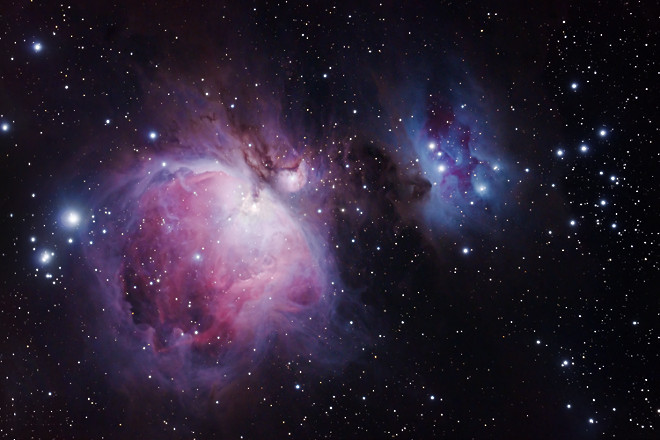
Get outside with your telescope on clear May evenings to see celestial treats! With weather warming up and skies clearing up, there's no shortage of celestial delicacies to view with telescopes and binoculars. Here are a few of Orion's top suggestions for May observing:
- Eta Aquarid Meteor Shower - Grab a blanket or a comfy lounge chair to sit back, relax and watch the Eta Aquarids meteor shower, which peaks on May 5th into the early morning hours of May 6th. Dark skies courtesy of the New Moon of May 6th make it especially worthwhile to get outside this year for opportunities see meteors streak across the night sky at the approximate peak rate of 40 per hour. Look for meteors appearing to radiate from the constellation Aquarius.
- Transit of Mercury - For the first time since 2006, planet Mercury will transit across the face of the Sun as seen from Earth on May 9th from 11:12 UT to 18:42 UT. This planetary transit will provide well-equipped earthbound observers with a rare opportunity to see the tiny disk of Mercury silhouetted against the Sun. With a properly fitted Orion Solar Filter attached to your telescope, you can safely enjoy this spectacular show with friends and family, or even capture astrophoto keepsakes. Mercury won't cross the face of the Sun again until November of 2019, so don't miss out!
- Four Big Planetary Nebulas - Use a 6" or larger telescope and an Oxygen-III or UltraBlock filter to catch nice views of four relatively large planetary nebulas in May skies. See the "Ghost of Jupiter," NGC 3242 in Hydra; M97, "the Owl Nebula" in the Big Dipper; NGC 4361 in Corvus, and the famous "Ring Nebula", M57 in Lyra just a few degrees from bright star Vega.
- Mars at Opposition - On May 22, the Red Planet will reach opposition, making its closest approach to Earth in its orbit. Since Mars will be directly opposite the Sun in the sky as seen from Earth, the planet will rise at sunset and set at sunrise, providing a welcome opportunity for great views in a telescope. Opposition is arguably the best night of the year to observe and capture astrophotos of our next-door neighbor planet Mars. You can easily enhance your telescopic views of Mars with our exclusive, custom-designed Orion Mars Observation Filter to eke out details of subtle Martian landscape features.
- Five Glittering Globulars - Five picture-perfect examples of globular star clusters will be visible in May skies. Check out M3 in the constellation Boötes. M13, the "Great Cluster in Hercules" will be visible near the zenith. M5 can be found in Serpens, and M92 in the northern section of Hercules. Be sure to track down M4 (NGC 6121) in Scorpius on May 27th, as it will be in a great position for telescopic study throughout the night, reaching zenith around midnight. Big telescopes will provide the best views, but even a pair of humble 50mm or larger binoculars will show you these dense balls of stars from a dark sky site.
- Four Face-On Spirals - Use a large telescope to see the classic pinwheel shapes of galaxies M51 and M101 in the Big Dipper asterism, and M99 and M100 in the Virgo galaxy cluster. There are also dozens of additional galaxies to explore in the Virgo cluster with a large aperture telescope.
- May's Challenge Object - May skies present some of the best opportunities to grab a view of Omega Centauri - the brightest globular star cluster in the sky! While it's big and bright, even visible as a "fuzzy" star in binoculars, the challenge Omega Centauri presents is its low position in southern skies, which can make it unobservable from higher northern latitudes.

Talented astrophotographer and resident "Product Guru" Steve Peters captured this ethereal portrait of our namesake nebula and the surrounding region using the new Orion EON 104mm ED-X2 Triplet Apo refractor attached to his trusty Sirius EQ-G GoTo Mount. The true-color performance provided by the two ED glass elements of the EON ED-X2 are on full display in this beautiful astrophoto.
All objects described above can easily be seen with the suggested equipment from a dark sky site, a viewing location some distance away from city lights where light pollution and when bright moonlight does not overpower the stars.













